Throughout 2025 (and for that matter, most of 2024), the narrative in the U.S. truckload market has been relatively consistent: lower freight volumes, waning carrier capacity, and a prolonged stable rate environment (though rates are increasing slightly on a year-over-year basis).
As we approach a new year, there are some signs that 2026 could finally see a meaningful shift in truckload market dynamics.
Across the industry, we’re seeing core shipper KPIs (e.g., primary tender rejections) deteriorate, an indicator that capacity is shrinking relative to demand.
What’s driving the supply/demand squeeze?
Is this just Q4 peak season volatility that will taper off in Q1, or will there be a recovery in 2026, and if so, how steep will it be?
And how should shippers be planning their procurement strategies for 2026?
We’ll tell you everything you need to know in the latest truckload market guide.
Q4 Truckload Market:
The Complete Guide for Logistics Pros
What you’ll learn in this comprehensive update:
- Q3 2025 truckload market recap
- Macroeconomic outlook
- 7 trucking trends to watch right now
- Q4 2025 truckload market forecast
New to the Curve?
These essential truckload market resources will give you foundational industry knowledge and teach you how how we build our proprietary spot rate index.
Want slides for your next presentation?
Download all the Curve charts and graphs, formatted for slides.
RXO & the Curve
RXO acquired Coyote Logistics in September 2024. As a new, combined company, we will not only continue publishing industry-leading insights (like the Curve) — we plan on making them even better. Now, as the now third largest full-truckload freight broker in North America, we’ll have an even broader, richer dataset to analyze. We look forward to bringing you more freight market content throughout 2025 and beyond.
Spot & Contract Trucking Rate Recap: Q3 2025
Overall, Q3 was soft in terms of freight demand and rate volatility.
Though the Curve spot rate index remained in year-over-year inflationary territory, it also declined sequentially for the third straight quarter (more on that below).
There were pockets of volatility, however, similar to previous quarters, their cumulative impact proved to be negligible. Each event brought about a , but the rate environment wasn’t able to hold a sustainable period of volatility to the upside.
- Q3 truckload spot rates remained inflationary, but less so compared to Q2
Truckload spot rates increased 1.8% year-over-year at the end of Q3, down from 6.5% in Q2 and declining sequentially for the third straight quarter. - Q3 truckload contract inflationary, increasing slightly from Q2
Truckload contract rates* increased 2.1% year-over-year, up slightly from 1.1% in Q2.
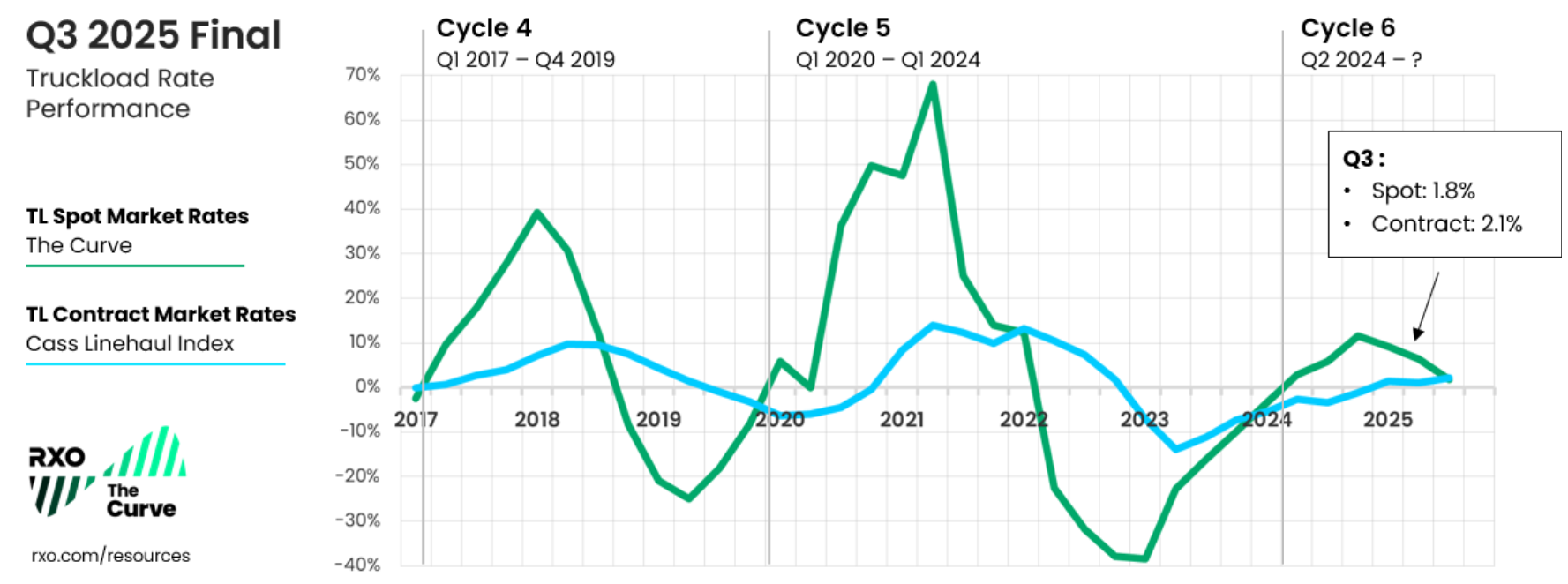
Download all the Curve charts for your next presentation.
Actual Spot Truckload Rates vs. Year-Over-Year
To build further confidence in the Curve (a year-over-year spot rate index), let’s see it up against our proprietary all-in cost-per-mile index — this is comparing annual change (without fuel) versus the actual rate (all-in cost, with fuel included).
As a reminder, these numbers are informed by real transactional data from thousands of daily shipments over the last 18 years.
Since Q3 2023, this index has remained essentially flat, with very little movement, ranging between 111 and 120 (for comparison, during COVID-era shipping in the early parts of the previous market cycle, the index troughed at 93.4 and peaked at 178.1).
In Q3 2025, the all-in index ticked up slightly to 116.3.
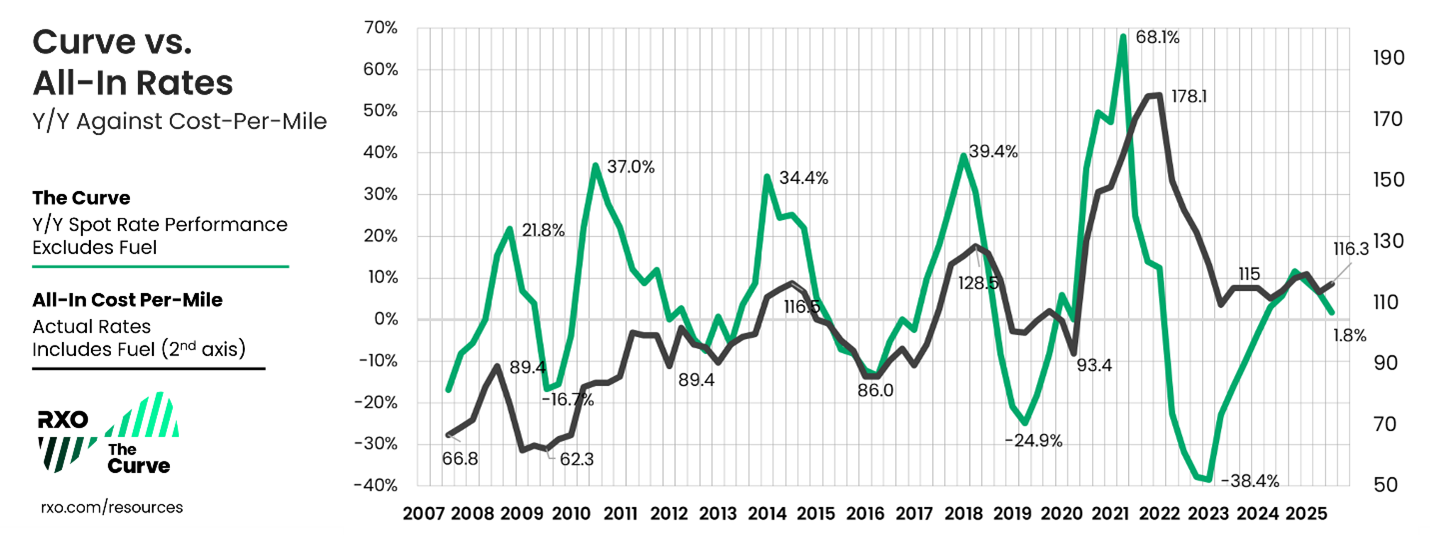
Download all the Curve charts for your next presentation.
The Curve has declined sequentially for three straight quarters — are we heading back towards deflation?
In previous truckload market cycles, when shipping events hit during the upswing into inflation, they tend to accelerate market activity (i.e., pouring lighter fluid on the bonfire).
In this market cycle, similar to the end of the previous cycle, major shipping events are not having the same impact. We’ve gone through produce season, DOT week, summer shipping, and peak season build up — none have had a lasting impact on spot market rates.
That said, though conditions have been relatively stagnant, no, this market cycle has not already peaked.
Let’s look at three reasons why:
1. We’ve seen trends reverse course during previous cycles.
This is far from atypical — look at previous cycles and you’ll find seven other examples of when the Curve has trended down during an upswing or trended up during a downswing.
The key is taking a long view of cycle activity to determine the overarching trend. Though this is certainly a longer deviation, the current dynamics of the truckload market are unable to support a deep drop into a trough (see next point).
2. It’d be difficult for rates to move materially lower.
Looking at the all-in index, in absolute terms, carriers are getting similar spot rates to those they were getting during the market peak in 2014, though their operating costs (diesel, insurance, labor, etc.) have risen significantly since then.
For context, the average marginal cost to operate a truck in 2024 was around 34% higher than in 2014, according to the American Transportation Research Institute.
Simply put, it is difficult for freight rates to drop materially, as many carriers have been running with unsustainable unit economics.
3. Any uptick in demand would drive rates higher.
Due to uncertainty in the U.S. economy, many shippers and consumers have been conservative when it comes to spending. Unemployment — though low by historical standards — is rising, consumer confidence is deteriorating, and the ISM Industrial Manufacturing Purchasing Manager’s Index (more on that below) has been in contractionary territory throughout most of 2025.
Encouragingly, the Fed has cut interest rates (and may make more cuts). Furthermore, the economy could benefit from other fiscal stimuli, including bonus depreciation associated with the One Big Beautiful Bill Act. To the extent that companies and consumers gain confidence in making purchases, it would lead to incremental freight demand and subsequent rate volatility.
While we don’t view a huge spike in demand as the most likely scenario, given the long period of low freight rates and carrier attrition, the supply / demand balance is fragile and is susceptible to any volatility.
Q3 2025 Truckload Market: Key Takeaways
- The Curve (measuring year-over-year in linehaul spot rates, excluding fuel) remained in year-over-year inflation (though slightly less than Q2), and all-in rates (actual amount paid to carriers) increased slightly.
- Though we are in an inflationary rate environment, Q3 was still predominantly a shippers’ market.
- Carriers remained under significant cost pressure, while shippers enjoyed relatively high tender acceptance rates, easy capacity and only slight rate increases in their RFPs.
State of the Industry: Macroeconomic Overview
Note: Due to the U.S. Government shutdown, several of the macroeconomic indicators we regularly report on are delayed. We will update when data becomes available.
Overall, the U.S. macroeconomic environment remains in a similar spot as last quarter’s update: relative stagnation in spending and production.
Through Q2 (most recent available), U.S. real gross domestic product (GDP) has remained stable, at 2.1% growth year-over-year.
Though some of the dust has settled on tariffs and trade policy shifts from earlier in the year, there is a looming overhang of uncertainty and consumer anxiety.

Inflation & Interest Rates
Though inflation has eased considerably over the past two years, it remains persistently higher than the Federal Reserve’s target rate of 2%.
September’s Consumer Price Index (CPI) reading (+3.0% year-over-year) was the highest since January and has risen consistently since the index notched a four-year low in April.
The core Consumer Price Index (CPI), which excludes volatile food and energy costs, rose at a slightly slower pace in September (3.0% year-over-year, ticking down from 3.1% in August).
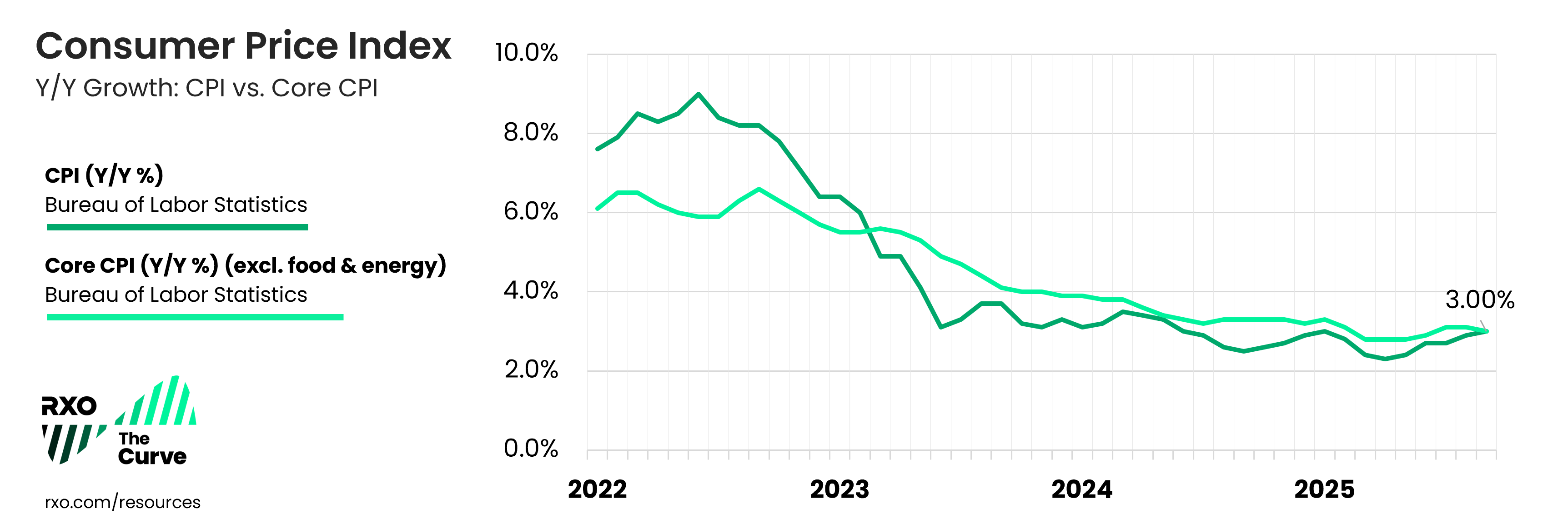
Tariff and Trade Policy Impact
The U.S. government has struck several important deals with major trading partners, and the administration has also proved willing to work with certain sectors of the economy (e.g., the automotive industry).
The overall situation we laid out in our Q3 update is still largely true today:
- Some shippers still have non-tariffed goods throughout their supply chains, and others may have absorbed the cost of tariffs, anticipating further changes in trade policy.
- If higher tariffs go into effect, shippers will either absorb the elevated costs, impacting corporate profit margins, or pass them through to consumers.
What’s new in Q4: will a Supreme Court decision strike down the Trump Administration’s tariffs?
The legal basis for much of the Administration’s trade policy hinged on the ability to use broad emergency powers to implement tariffs. In the past, tariffs were generally under the purview of Congress.
Several small businesses and a group of states are challenging the legality of these tariffs, which they contend are an overreach of executive branch authority. The case made its way through the lower courts, and reached the U.S. Supreme Court, which had an initial hearing on November 5th.
If overturned, the ruling could have a massive impact on the economy, as many of the volatile trade policy shifts from earlier this year would be essentially reversed.
At this time, it’s too early to speculate exactly how this will play out. Furthermore, the timeline is unclear — often, high-profile cases take many months to resolve, though the court can also act swiftly when a deadline is involved.
Consumer Confidence
Though the inflationary impact of tariff implementation has been less than originally feared (at least, so far), the U.S. consumer is still leery of how looming tariffs will impact the economy.
After consumer sentiment fell to its third lowest level in recorded history in April and May (according to the University of Michigan Consumer Sentiment Index), it rebounded slightly in June and July, then dropped in August, September and October, hovering around all-time lows.
Ultimately, inflation and the potential for future interest rate cuts are inextricably linked to changes in trade policy, which has been highly fluid.
Though recent deals have de-escalated global tensions, persistent higher tariffs have the potential to accelerate inflation in the near-term.
The Federal Reserve and Rate Cuts
After multiple rate cuts in 2024, the Fed sat tight until their September meeting, when they cut interest rates by 25 basis points (bps). In October, the Fed cut rates again, by an additional 25 bps.
When it comes to additional interest rate cuts, a cut at the upcoming December Fed meeting is not a foregone conclusion.
The Fed has a dual mandate of promoting both price stability and maximum employment.
Inflation remains stubbornly high (and has been trending the wrong direction), while labor markets are cooling, the macroeconomy is slowing and the housing market is stagnant.
As Fed Chair Powell said at their last meeting, “In the near term, risks to inflation are tilted to the upside and risks to employment to the downside—a challenging situation.”
Industrial Demand
Early in the year, the industrial sector of the U.S. economy was beginning to show signs of improvement.
After 26 straight months of contraction, the Manufacturing Purchasing Manager’s Index (PMI) entered into expansionary territory in January and February.
However, since March, the index has sunk back into contraction.
The New Orders component of the Manufacturing PMI — one of the strongest leading indicators for U.S. economic activity — had been improving for five consecutive months, then dropped. In August, New Orders jumped back into expansion, then sank back into contraction for the past two months.
If the Fed continues to cut interest rates, it’s possible we’d see a boost in this index, as businesses would have cheaper cost of capital to invest in and expand their operations.
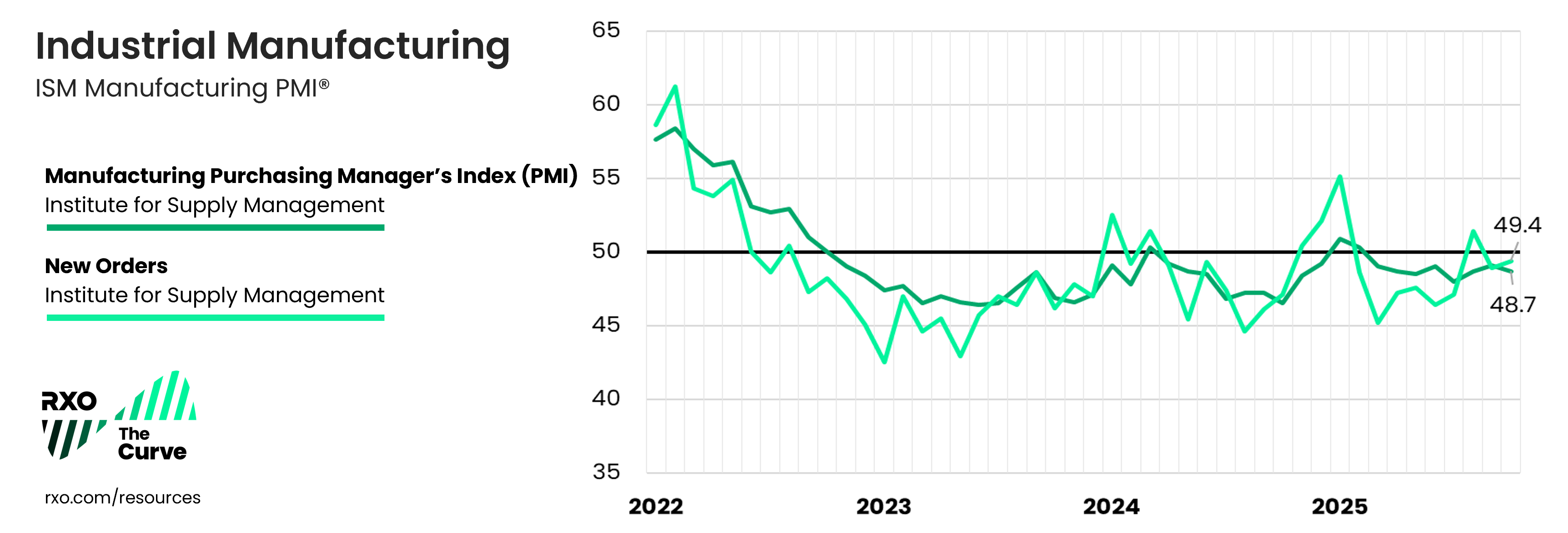
Key Economic Indicators Driving the Truckload Market
Now that we’ve covered the broader economy, let’s look at some indicators that are most closely linked to truckload market activity.
Overall, we’ve seen relative stagnation in these indicators (with the exception of imports; more on that below), perpetuating the trend of muted truckload volumes, which have, in turn, slowed down a freight market recovery.
Let’s examine the most recent available figures for industrial production, consumer spending, imports and inventories through the lens of how they are impacting truckload shipping.
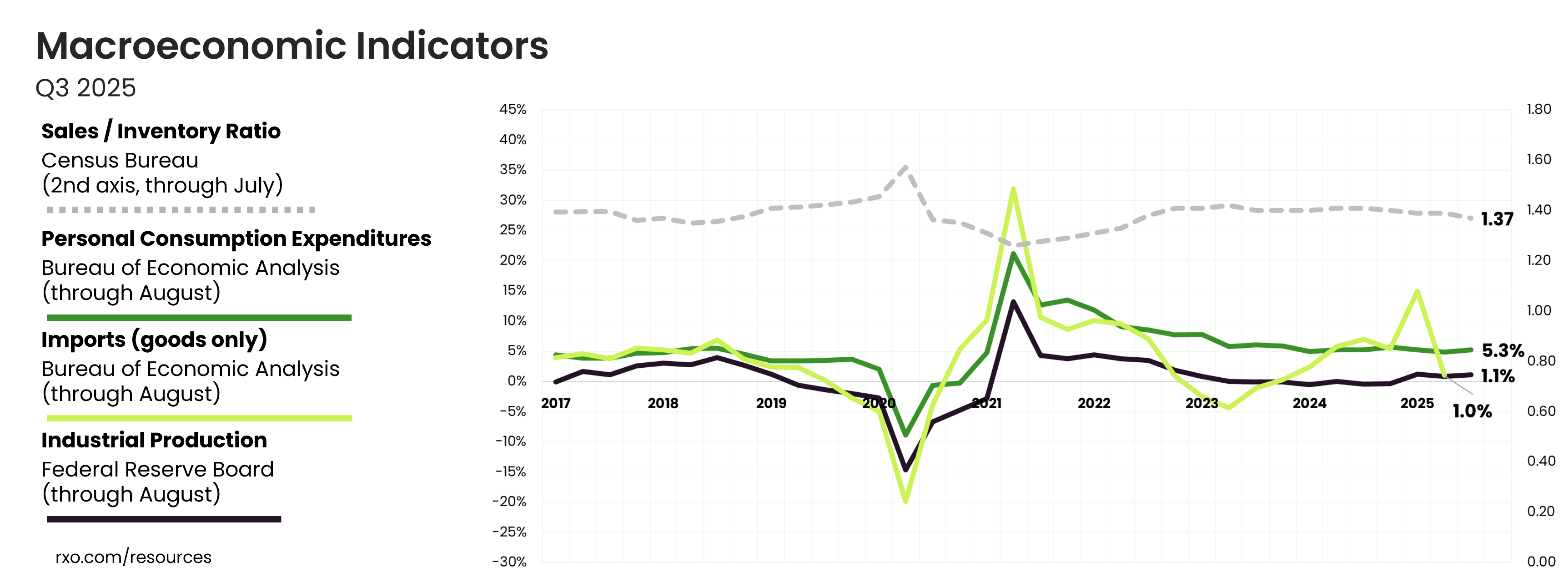
Download all the Curve charts for your next presentation.
Note: Truckload Market Inflation/Deflation vs. Economic Growth/Recession
It’s worth noting that though the truckload market is linked to what happens in the wider economy, the two are not always coupled.
Given how supply and demand work in the truckload market, it’s possible for the economy to remain strong and the truckload market to languish. It’s also possible for the truckload market to inflate while the economy weakens (see the inflationary Curve in 2008 during the Great Recession).
More specifically, looking at the current environment, carriers are combating lagging freight volumes, a continuation of muted spot market rates and inflation in their overall cost structures (labor, insurance, etc.).
A continuation of these trends could topple even more carriers who have been barely hanging on for the last two years. Any significant reduction in the carrier base could drive up rates, even in a lower demand environment (e.g., an economic recession).
Personal Consumption Expenditures
- What is it?
How much the American consumer is spending - How it impacts truckload shipping:
The more we buy, the more we need to produce (IP) and/or buy elsewhere (imports), which translates to greater demand for truckload shipping.
While we’ve had more than two years of persistent inflation and fears of a possible recession, consumer spending has remained stable, helping to buoy the overall economy.
Though the rate of growth has steadily slowed since Q4 2021, it is still growing — in Q3 (through August, most recent available) the Personal Consumption Expenditures Index is at 5.3% year-over-year, essentially flat from 5.2% in Q1.
Goods vs. Services in Consumer Spending
When COVID struck, service-related industries closed and, in turn, demand for physical goods (which required more freight shipping) soared to 15-year highs in an incredibly short period of time, driving a commensurately high inflationary spot market.
Over the past several years post-COVID, U.S. consumers have increased their preference for services (vacations, dining, entertainment, etc.), which has decreased physical goods’ share of wallet, resulting in less freight.
Though the rate of decline for total spending on goods has stabilized, it is still tracking below the baseline average (32%) of the 2010’s. We’ll look for any increase in this to drive more freight demand in the coming .
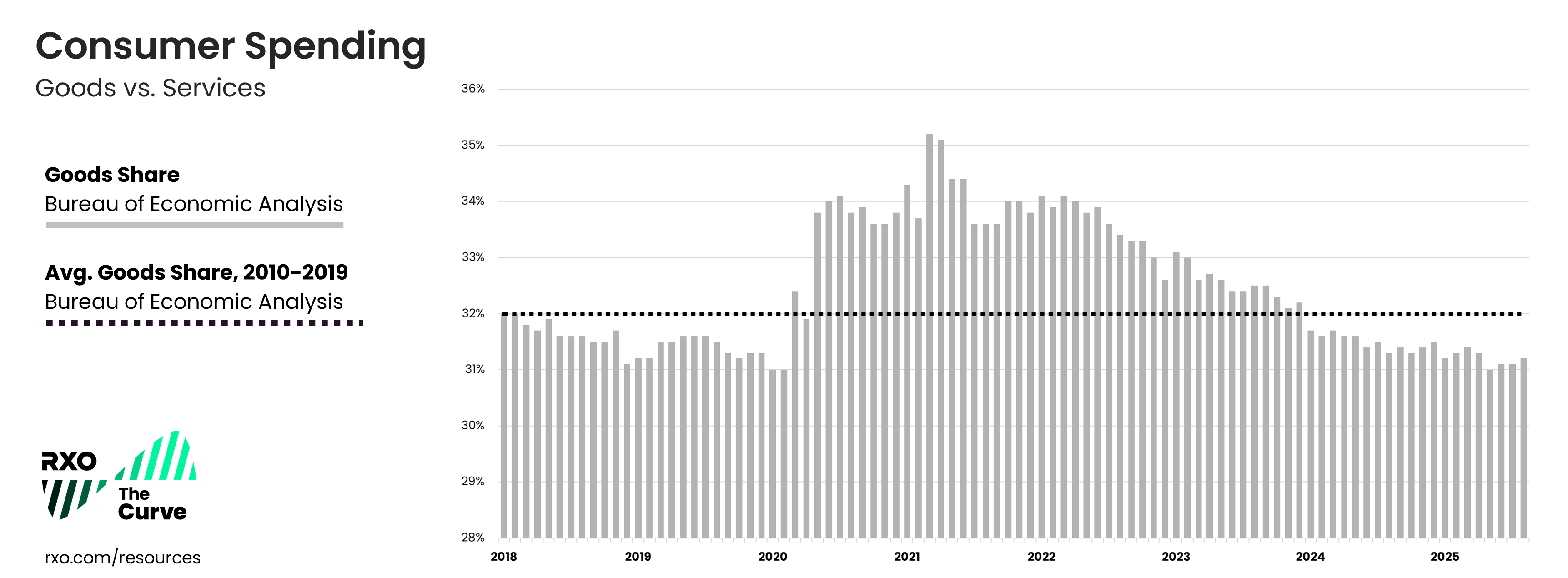
Industrial Production (IP)
- What is it?
Total value of physical goods America is producing - How it impacts truckload shipping:
The more we make, the more freight that needs to move, from raw material inputs to finished goods
After trending downwards for several quarters, Industrial Production had a slight bump upwards in Q1, hitting 1.5%. In Q2, the index dipped slightly to 0.9% and in Q3 (through August, most recent available) bumped up to 1.1%.
Imports (Goods Only)
- What is it?
Total value of physical goods America is buying from other countries - How it impacts truckload shipping:
The more we buy from other countries, the more freight that needs to move, from raw material inputs to finished goods
After a short-term increase driven by tariffs (many shippers were scrambling to replenish inventories with non-tariffed goods before updated trade policies set in), this index has come back down to earth.
Imports (of goods, excluding services) ended Q2 at 1%, a sharp decline from Q1 at 15% year-over-year.
Furthermore, continued consumer preference of services over goods could also have a dampening effect to import growth.
Ocean vs. Truckload Shipping
Though imports have tapered off dramatically after the Q1 surge, it’s worth noting that it is still possible to see a flurry of domestic truckload shipments throughout the holidays.
Much of that inventory built up earlier in the year could move from the warehouse to the store, fulfillment center or doorstep, all of which would increase over-the-road moves.
Inventory-to-Sales
- What is it?
The ratio of physical goods businesses have in stock vs. how much they’re selling - How it impacts truckload shipping:
When inventory levels are high, it creates a delay in demand for truckload shipping, as businesses will work off excess inventory before producing new goods (IP) or buying more goods (imports).
After peaking at 1.42 in Q2 2023, the index trended down slightly, and then remained mostly flat for every month since.
Interestingly, though many expected the ratio to increase as shippers tried to stockpile non-tariffed goods prior to tariff implementation, it has actually trended down slightly. Through July (the most recent data available), the index is sitting at 1.37.
With the index remaining stable for the past two years, the post-COVID destocking efforts were successful, and we’re back in a more normative restocking cycle.
To that point, U.S. retailers’ inventory positions have continued to grow at a slower rate than their revenue, a sign that shippers are once again more comfortable with a “just in time” inventory strategy.
Given recent supply chain stability, combined with consumer preference for the service economy, retailers
have been reluctant to build up significant inventory levels like they did in 2022 and 2023.
Macroeconomy & the Truckload Market: Key Takeaways
- Despite continued headwinds over the past two years, the U.S. economy has avoided a recession (at least for the time being), buoyed by stable consumer spending.
- We are operating in a fluid environment — tariffs and trade policy are driving significant economic uncertainty, which has led to declining consumer confidence and rising long-term inflation expectations.
- The last time the freight cycle went inflationary (2020 – 2021), surging demand drove rate growth. For this inflationary leg, the current macroeconomic outlook doesn’t support a massive spike in demand — it’s more likely that supply-side constraints (carrier attrition) will likely be the driving force.
- That said, any tariff de-escalation and/or fiscal and monetary stimulus, could spur increased demand (and subsequent supply chain volatility) during peak season.
Truckload Market Trends to Watch in Q4 2025
Let’s unpack a few of the key trends impacting the market before we dive into the updated Q4 forecast.
1. Spot rates continue to trail contract rates (for now).
For the past few years, shippers have used their transportation RFPs as opportunities to bring their contract rates (aka primary rates) back towards pre-pandemic levels — and they were largely successful.
Even though spot rates have bounced off the bottom and been year-over-year inflationary for several quarters, they are, in absolute terms, unable to consistently overtake contract rates.
This held true through produce season and summer shipping, when it almost always becomes tighter.
While it’s possible we’ll see this dynamic flip during peak season, early signs point to relative stability.
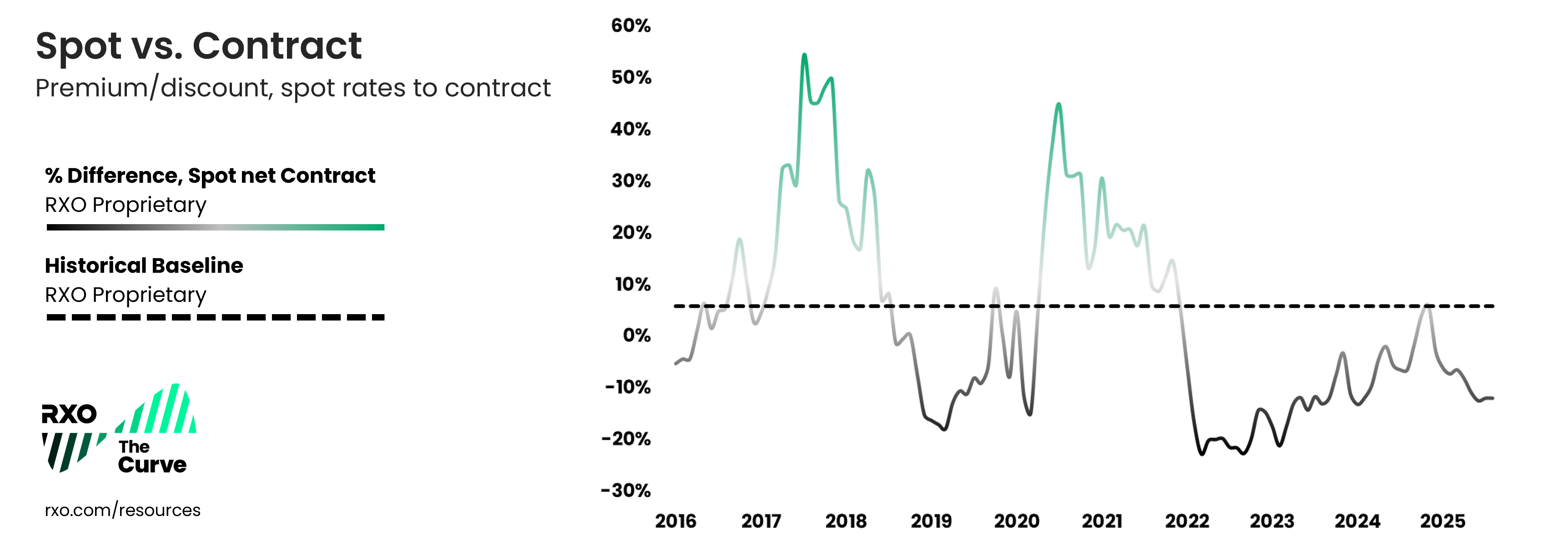
The persistence of these low rates, both in contract and spot, is placing an immense amount of pressure on carriers. If (and likely, when) enough carriers get driven out of the market, it will trigger a rise in spot rates, but the timeline for the flip keeps getting pushed out given weak conditions.
When it does eventually happen, those contract rates and routing guides set in the softer market may not survive a tighter market, when the spot market will become more lucrative than the contract market.
2. Federal policy enforcement is straining carrier capacity.
There are two federal policy initiatives, primarily aimed at the immigrant driver population, that are impacting the carrier market.
Combined with increased immigration enforcement spending in the One Big Beautiful Bill Act, these policies could lead to a noticeable reduction in the overall driver pool.
The extent to which either will constrain capacity — both in the short- and long-term — remains to be seen, but we’re already experiencing the first signs of tightening.
Even for immigrant drivers with legal and compliant status, it’s possible the increased atmosphere of enforcement (e.g., Immigration and Customs Enforcement raids) is having a chilling effect, causing some to opt to stay at home or seek other employment.
Let’s briefly unpack both.
English Language Proficiency
Existing federal law requires that all commercial truck drivers must: “read and speak the English language sufficiently to converse with the general public, to understand highway traffic signs and signals in the English language, to respond to official inquiries, and to make entries on reports and records.”
On April 28th, President Trump signed an Executive Order that places a renewed and increased focus on enforcement of the English proficiency standard.
Starting on June 25th, the Department of Transportation and FMSCA began enforcing this requirement, placing non-compliant drivers out-of-service.
Non-Domiciled CDLs
What is a non-domiciled CDL?
In brief, this type of state-issued CDL primarily applies to foreign nationals who are legally in the U.S., but not citizens or permanent residents. Note: This does not apply to Canada and Mexico, whose citizens must obtain their CDL from their home country.
A non-domiciled CDL gives these individuals the opportunity to drive in the for-hire truckload market, provided they complete an application, pass a driving test and provide authorization from U.S. Immigration.
What is happening to non-domiciled CDLs?
The FMCSA issued an interim final rule in late September, that, “Closes gaps in how states issue CLPs and CDLs to individuals from outside of the United States. It tightens eligibility, strengthens safeguards, and makes clear when these licenses must be canceled or revoked, delivering a more secure system and safer roads for all Americans.”
Or to put it simply for our context, it makes it significantly harder (or impossible) for many foreign nationals to drive a commercial vehicle in the U.S.
The rule went into immediate effect but is still open for public comment through the end of November. It is also facing legal challenges. Specifically, on November 10, 2025, the U.S. Court of Appeals for the District of Columbia Circuit issued an administrative stay of the interim final rule.
However, States that are subject to a corrective action plan that imposes a pause on non-domiciled CLP and CDL issuance until evidence of compliance with FMCSA’s regulations and guidance, in effect immediately prior to issuance of the interim final rule, has been provided to FMCSA must continue to comply with the requirements of the plan.
Why does this matter?
The massive and highly fragmented U.S. truckload market is notoriously difficult to quantify, particularly the subsection of the driver population to whom this rule applies (i.e., owner-operators and small fleets), so it’s difficult to say exactly how many drivers it affects.
However, if this rule stays in effect and is fully enforced, it will remove thousands of drivers from the road (nearly 200,000, per FMCSA estimates). This could result in the biggest structural change to the supply side of the truckload market since trucking deregulation in 1980.
This administration is serious about enforcement and is fully prepared to allocate funds, withhold funds to noncompliant states, and codify these changes into federal law.
Another consideration — given the current final rule, insurance companies will be far less likely to extend coverage to carriers that employ non-domiciled CDLs, which would effectively push them out of the market regardless of more direct government enforcement.
All of this is coming at a time when carrier capacity has been waning amidst persistently weak spot market rates and could be the straw that breaks the camel’s back, sending the market up to a true peak when demand eventually recovers.
3. Carrier employment continues to wane.
As freight volumes and rates have been muted over the past two years, so has driver employment.
Looking at employment data from the Bureau of Labor Statistics (BLS) (which only accounts for W2 employees at fleets, not owner-operators), carrier attrition continues, and we can see drivers exiting the market.
All employees, truck transportation
(from the BLS, through August)
- Decreased sequentially for 16 of the past 24 months
- Decreased year-over-year for 20 of the past 24 consecutive months
Production & non-supervisory employees, long-distance trucking
(aka drivers, from the BLS, through July)
- Decreased sequentially for 15 of the past 24 months
- Decreased year-over-year for 27 consecutive months
4. Operating authorities continue to wane, too.
The FMCSA tracks carrier operating authorities (new grants, revocations and reinstatements).
As mentioned above, owner-operators do not generally show up in employment numbers. Looking at operating authority activity is another way to get a pulse check on a large, fragmented carrier base.
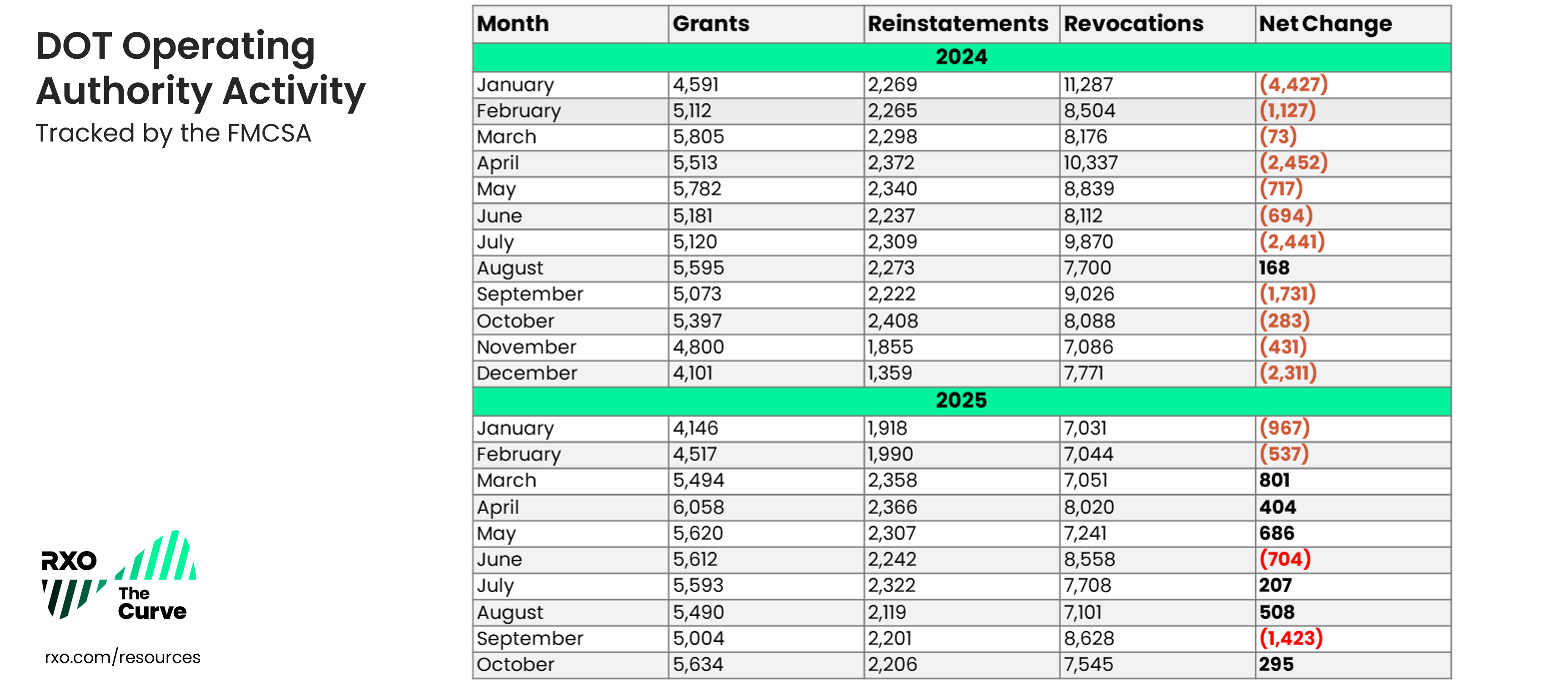
Though employment was trending down, in April, May, July and August, Operating Authorities grew, which was an anomaly — typically, given the current difficult landscape for carriers, revocations should outpace reinstatements and new grants.
What probably happened:
- Shuffling of drivers from fleets to owner-operators
Large fleets were reducing their driver base, and these drivers were reinstating or setting up new authorities. - Seasonality
Generally, in the spring, operating authority grants increase after a winter of (often) weaker freight volumes.
What’s happening now:
Year to date, there has been a net decrease of -1,134 and the population has declined in 18 of the last 24 months, leading to a total decrease of over 17,500 operating authorities over that time frame (for context, there were around 100,000 additions from 2020 to 2022).
Absent a market recovery, elevated insurance premiums and continued cost inflation will likely lead to continued carrier exits over the coming months, particularly those with more exposure to the spot market.
5. Class 8 truckload orders continue to drop.
Looking at past truckload market cycles, when times are good for carriers (i.e., high spot rates), they order more trucks, and vice versa. Throughout much of 2023, though truckload rates were deflationary, orders remained curiously strong.
In 2024, we finally started seeing truckload order trends catch up to market conditions and we continue to see that trend build. In Q2, class 8 tractor orders (as tracked by ACT Research) were down -10.0% year-over-year, and Q3 sank even lower, finishing at -22% year-over-year, with each month dropping deeper (figures were -2.1%, -19% and -44% in July, August and September, respectively).
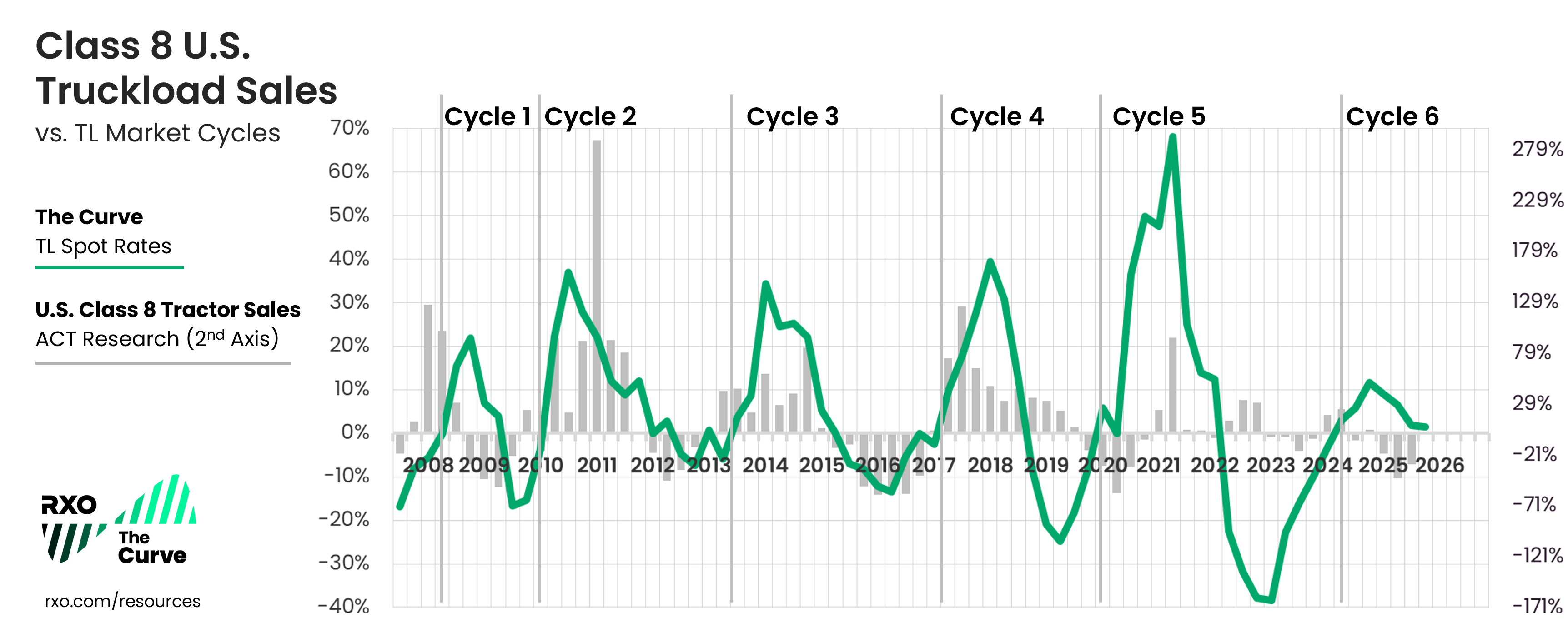
This is another indicator showing the financial strain on the supply base from the prolonged soft freight market.
Combined with high interest rates and a lack of clarity in the regulatory environment, fleets are purchasing the minimum amount of new equipment.
We’ve also seen a significant pullback from large private fleets, which has been a major tailwind to truckload spot rate expansion during this cycle.
In response to COVID-era volatility, many shippers built out their private fleets. When demand tapered off in 2023, this incremental new fleet capacity was soaking up a lot of freight that would have previously hit the for-hire market, prolonging the down-cycle.
Any continued reduction of large private fleet capacity will be a net gain to the for-hire market.
6. Peak volumes will probably be softer than last year.
Generally speaking, freight demand (covered in detail in the macroeconomic section above) has been lagging, leading to weaker truckload volumes and stable spot market rates.
Earlier in the year, we predicted that we could see a snap back in demand as trade deals were struck, and shippers looked to build inventory ahead of Q4 peak season.
This did not materialize in a meaningful way, and all signs point to a muted peak from a freight demand perspective.
7. The supply / demand balance is fragile, and susceptible to any volatility.
We’ve outlined the capacity situation in detail (waning employment, decreasing authorities, pressure on the immigrant driver pool, low rates and low freight volumes).
And though demand has been stable and doesn’t appear to be surging in the next few months, continued carrier attrition over the next few months could set up a difficult shipper’s market in 2026, one where any improvement in truckload volume could spell widespread disruption.
Truckload Trends: Key Takeaways
- Much has remained the same since our last update: Freight volumes are sluggish, contract and spot rates are comparable, carriers are buying fewer trucks, and carrier attrition in employment continues.
- The biggest potential change is federal policy targeting immigration enforcement on the driver population.
- The speed and severity of the upward climb will depend on if we get an increase in freight demand, how fast carrier capacity exits the market, or a combination of the two.
- Relatively speaking, the capacity situation is much more fragile than at this time last year. With a continued difficult landscape for carriers, it could set the stage for volatility in 2026.
Q4 2025 Truckload Market Forecast
We’ve covered the macroeconomic environment, and key trends — but where does it leave us going forward?
We predict the Curve will continue its move into inflationary territory.
Though capacity and rates might feel stable, we’re in a changing environment; the carrier market is in a much more precarious place than it was over the last few years.
Q4 to Date
The Curve index has started off Q4 sequentially lower than Q3, however, this is mostly due to the fact that the Curve is a quarterly average — we are only halfway through the quarter at the time of publishing.
In Q4 last year, December was very strong, largely driven by a surge in imports as shippers pulled volume forward ahead of impending tariffs. In Q4 to date this year, both October and November have outperformed year-over-year, and it is likely that the Curve will end the quarter slightly higher than its current position.
Even if Q4 finishes flat or slightly down compared to Q3, we still do not predict the Curve is heading back into deflation. In Q4, it’s most likely that spot rates remain in a state of limbo, without a dramatic movement in either direction.
Interestingly, though we’re starting to see buy rates with carriers accelerate in the RXO network, shippers have yet to feel the squeeze in their routing guides. Why is that? Because the spot market isn’t currently offering much (or any) premium to their contract rates, there is little-to-no incentive to jeopardize shipper relationships in a weak demand environment.
But that could all change in 2026.

2026 Outlook
We expect carrier capacity to continue leaving the market, especially if the new FMCSA final rule on non-domiciled CDLs is fully enforced.
As stated previously, we believe this could be the biggest structural change to the U.S. carrier market since industry deregulation in 1980 — much more than the ELD mandate in 2017. But this is a dynamic situation with ongoing litigation challenges.
Though 2025 contract rates slightly increased year-over-year in Q3, at some point next year, spot rates are likely to rise at a faster rate. Eventually, spot rates will overtake contract rates, and this divergence will drive volatility as cash-strapped carriers look to increase profitability after a very difficult three years.
It’s quite possible we’ll see a lower potential market peak; for guidance, a look back to 2014 would likely be a better comparison.
We may still get a more traditional peak if we experience any combination of an increase in demand, a faster-than-expected exit of carriers or a spike in diesel, but we think a conservative outlook is more likely.
A lot of it will hinge on stability (or lack thereof) in trade policy, the extent to which drivers leave the market, and how shippers and consumers respond.
Is the truckload cycle broken?
At this point, with quarter after quarter resulting in a similar update, it’s worth asking the question: did COVID-era supply chain volatility break the truckload market cycle? We don’t think so.
Regardless, the fundamental market structure (large, fragmented carrier base) is still the same (even with the enforcement of non-domiciled CDLs).
Instead, we think this is an especially bad hangover after an especially wild ride in 2021 and 2022.
Carriers made an exceptional amount of money, capacity grew by an exceptional amount, and it’s taking an exceptionally long time for the market to return to equilibrium.
Though this cycle peak may be atypical to previous — it may very well dip into deflation (without hitting a real trough) — we believe it will rise up to a more traditional peak in 2026.
Q4 2025 Forecast: Key Takeaways
- Q4 will likely have muted demand, and though carrier capacity is waning, it is unlikely to cause volatility this quarter.
- The Curve index will likely finish both year-over-year inflationary and higher than the current quarter-to-date, but it is likely not going to see significant acceleration in the near-term.
- Carriers remain under immense cost pressure, and an increase in carrier exits and/or an increase in freight demand would drive the market higher into inflation.
- Though the market continues to be stable, and the Curve has trended down in recent quarters, it is more likely we’re in the calm before the storm rather than looking at a continuation of current trends.
Next Steps: Get Your KPIs in Order With the Latest Research
Did you know that 99% of carriers take shippers KPI expectations into account before agreeing to move a load with them?
As we head deeper into an inflationary market, it’s the perfect time to check yours up against industry standards.
We recently published the 2025 edition of our original, independent research study on logistics KPIs, and it’s loaded with insights and benchmarks, informed by 1,000 shippers and carriers.
Check out the research study now to start having a more data-driven network.


